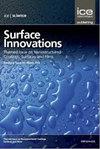Preparation and characterization of air sprayed silk fibroin/silica-based thermal-insulation coatings on catheters for cerebral hypothermia therapy
IF 3.5
4区 材料科学
Q3 CHEMISTRY, PHYSICAL
引用次数: 1
Abstract
Clinical practice of therapeutic hypothermia for neuroprotection in acute cerebral ischemia has been hindered by warming effect on the cold infusate along pathway, which results from the poor thermal resistance of traditional interventional catheter. In this study, thermal insulation coatings with different spray parameters and coating suspension compositions were prepared via air-spraying on Nylon substrate for biomedical application. The surface morphology and microstructure of coatings were investigated by scanning electron microscope (SEM), X-ray diffraction (XRD), Fourier Transform infrared spectroscopy (FTIR), respectively. Silk fibroin (SF) and hollow silica based nanospheres (HSBNS) were successfully sprayed on Nylon substrate. The thermal conductivity of coating measured by light flash apparatus is down to 0.00105 W/(m·K). The tape test indicates that coatings containing SF, HSBNS and glyceryl have good adhesion which is a promising method to enhance the thermal insulation performance of traditional catheter for cerebral hypothermia therapy.空气喷涂丝素/二氧化硅基脑低温治疗导管隔热涂层的制备与表征
由于传统介入导管的耐热性差,对通路上的冷输液产生加温作用,阻碍了治疗性低温对急性脑缺血神经保护的临床实践。本研究采用空气喷涂的方法在尼龙基体上制备了不同喷涂参数和涂层悬浮液组成的隔热涂层,用于生物医学应用。分别用扫描电子显微镜(SEM)、X射线衍射仪(XRD)、傅立叶变换红外光谱(FTIR)对涂层的表面形貌和微观结构进行了研究。成功地将丝素蛋白(SF)和中空二氧化硅基纳米球(HSBNS)喷涂在尼龙基体上。用闪光装置测得涂层的导热系数降至0.00105 W/(m·K)。胶带试验表明,含有SF、HSBNS和甘油基的涂层具有良好的粘附性,这是一种很有希望提高传统脑低温治疗导管隔热性能的方法。
本文章由计算机程序翻译,如有差异,请以英文原文为准。
求助全文
约1分钟内获得全文
求助全文
来源期刊

Surface Innovations
CHEMISTRY, PHYSICALMATERIALS SCIENCE, COAT-MATERIALS SCIENCE, COATINGS & FILMS
CiteScore
5.80
自引率
22.90%
发文量
66
期刊介绍:
The material innovations on surfaces, combined with understanding and manipulation of physics and chemistry of functional surfaces and coatings, have exploded in the past decade at an incredibly rapid pace.
Superhydrophobicity, superhydrophlicity, self-cleaning, self-healing, anti-fouling, anti-bacterial, etc., have become important fundamental topics of surface science research community driven by curiosity of physics, chemistry, and biology of interaction phenomenon at surfaces and their enormous potential in practical applications. Materials having controlled-functionality surfaces and coatings are important to the manufacturing of new products for environmental control, liquid manipulation, nanotechnological advances, biomedical engineering, pharmacy, biotechnology, and many others, and are part of the most promising technological innovations of the twenty-first century.
 求助内容:
求助内容: 应助结果提醒方式:
应助结果提醒方式:


